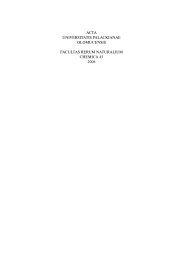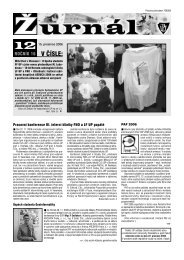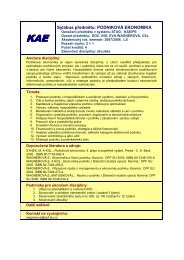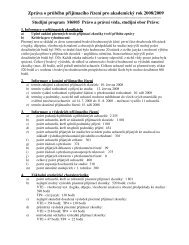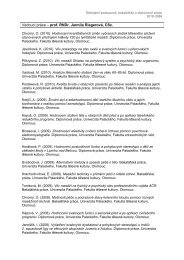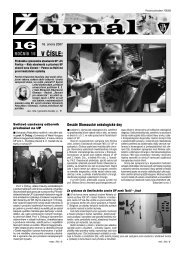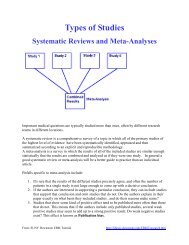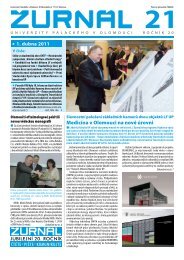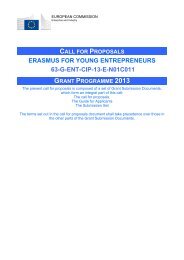ACTA UNIVERSITATIS PALACKIANAE OLOMUCENSIS GYMNICA ...
ACTA UNIVERSITATIS PALACKIANAE OLOMUCENSIS GYMNICA ...
ACTA UNIVERSITATIS PALACKIANAE OLOMUCENSIS GYMNICA ...
- No tags were found...
You also want an ePaper? Increase the reach of your titles
YUMPU automatically turns print PDFs into web optimized ePapers that Google loves.
Acta Univ. Palacki. Olomuc., Gymn. 2004, vol. 34, no. 2 65limbs was evaluated. After exercise of moderate intensitythere was a significant improvement (p < 0.05) of meanresponse time from 369.3 ± 38.6 ms to 339.6 ± 24.3 ms(Fig. 7). On the other hand, after exercise above theanaerobic threshold, there was a signifi cant increase(p < 0.05) from 338.3 ± 43.9 ms to 412.5 ± 47.0 ms(Fig. 8) indicating that multiple reaction time of thelower limbs depends on the type of fatigue.Such a phenomenon was observed in several studies.McMorris & Keen (1994) have demonstrated thatsimple reaction time after maximally fatiguing exercisewas significantly slower than after moderate exercise.Similarly, during exercise with increasing intensity upto exhaustion it was found that the multiple reactiontime decreased until the intensity exceeded the lactatethreshold by approximately 25%, and then rapidly increased(Chmura et al., 1994). However, it has beenreported that young athletes are able to maintain for arelatively long time, or even increase, their psychomotorperformance during exercise not only below but alsoabove the lactate threshold (Chmura et al., 1998). Forsuch a positive effect of exercise on cognitive functioningan enhanced activation is very probably responsible(Hogervorst et al., 1996) and both the peripheralcomponent (muscle contraction) and central nervoussystem integrity, primarily reflect cognitive processingspeed (Birren et al., 1980).Aside from diagnostics, the test may be applied forthe purpose of the development of agility skills in varioussports. Subjects may react from a position in themiddle of the square of four pads or from the location ofthe last stimuli. In addition, the device offers a variety oftest settings, i.e. time generation (constant or random),number, form, and color of the stimulus, and color ofthe background.The test setting can be adjusted in accordance witha sport specific task, i.e. either four or two pads for karate(Zemková & Hamar, 1998) and fencing performers ortennis players (Psalman, 2002) in accordance with theirmovements on the field. In addition, a longer distancebetween mats (5 m) for basketball, hockey, soccer orvolleyball players (Zemková et al., 2003) may be used totest multi choice reaction times in the lower extremitiesas well as sprint performance (Fig. 1b). For these sportssuch a modified version of the test is considered to bea more specific and hence more suitable alternative forthe assessment of agility abilities.CONCLUSIONIt may be concluded that by means of the contactmats used, the multi choice reaction times and movementspeed in a variety of agility skills may be evaluated.The test allows talent identification, differentiation ofgroups of athletes with different demands on agility oflower extremities, assessment of the effect of specifi ctraining focused at the improvement of these abilitiesas well as development of agility skills in various sports(tennis, fencing, karate, ice hockey, soccer, basketball,volleyball, aikido, etc.).REFERENCESBirren, J. E., Woods, A. M., & Williams, M. V. (1980).Behavioral slowing with age: Causes, organization,and consequences. In L. W. Poon (Ed.), Aging in the1980s: Psychological issues (pp. 293–308). Washington,DC: American Psychological Association.Hamar, D. et al. (1997). Test agility. Bratislava: Oddelenietelovýchovného lekárstva Ústavu vied o športeFTVŠ UK.Hamar, D., & Zemková, E. (1998). Test disjunktívnychreakčno-rýchlostných schopností dolných končatín.Med Sport Boh Slov, 7(3), 74–78.Hogervorst, E., Riedel, W., Jeukendrup, A., & Jolles,J. (1996). Cognitive performance after strenuousexercise. Percept Mot Skills, 83(2), 479–488.Chmura, J., Nazar, K., & Kaciuba-Uscilko, H. (1994).Choice reaction time during graded exercise in relationto blood lactate and plasma catecholaminethresholds. Int J Sports Med., 15(4), 172–176.Chmura, J., Krysztofi ak, H., Ziemba, A. W., Nazar,K., & Kaciuba-Uscilko, H. (1998). Psychomotorperformance during prolonged exercise above andbelow the blood lactate threshold. Eur J Appl PhysiolOccup Physiol., 77(1–2), 77–80.Luknárová, A., & Zemková, E. (1997). Dynamikaz mien reakčných a rýchlostných schopností dolnýchkončatín v teste agility v juniorskej reprezentácii vovolejbale. In Hry v programech tělovýchovných procesů(pp. 87–90). Plzeň: Pedagogická fakulta ZČU.Luknárová, A., Zemková, E., Hamar, D., & Červeň, Ľ.(1998). Zmeny disjunktívnych reakčno-rýchlostnýchschopností dolných končatín v priebehu ročnéhotréningového cyklu. In Zborník z odborného seminárak 760. výročiu založenia mesta Trnavy (pp. 56–62).Trnava: Katedra telesnej výchovy a športu MtF STU.McMorris, T., & Keen, P. (1994). Effect of exercise onsimple reaction times of recreational athletes. PerceptMot Skills, 78(1), 123–130.Psalman, V. (2002). Reakčné a reakčno-rýchlostnéschopnosti tenistov. In Vedecký seminár Optimalizáciazaťaženia v telesnej a športovej výchove (pp. 100–104).Bratislava: Katedra telesnej výchovy SjF STU.Thomas, J. R., Gallagher, J. D., & Purvis, G. J. (1981).Reaction time and anticipation time: Effects of development.Research Quarterly for exercise and sport,52(3), 359–367.



